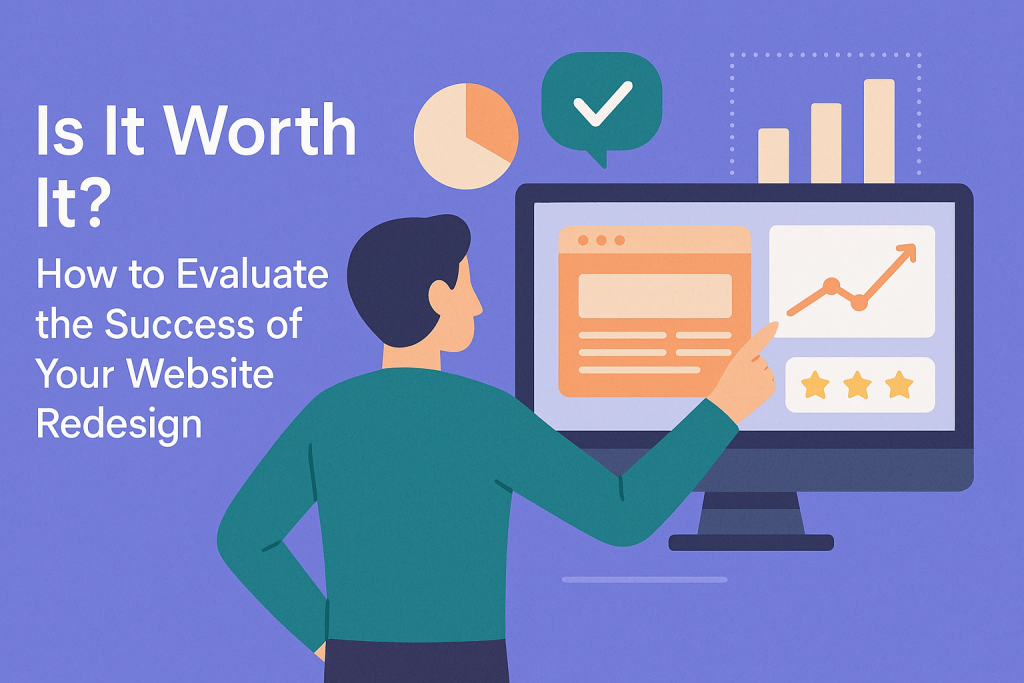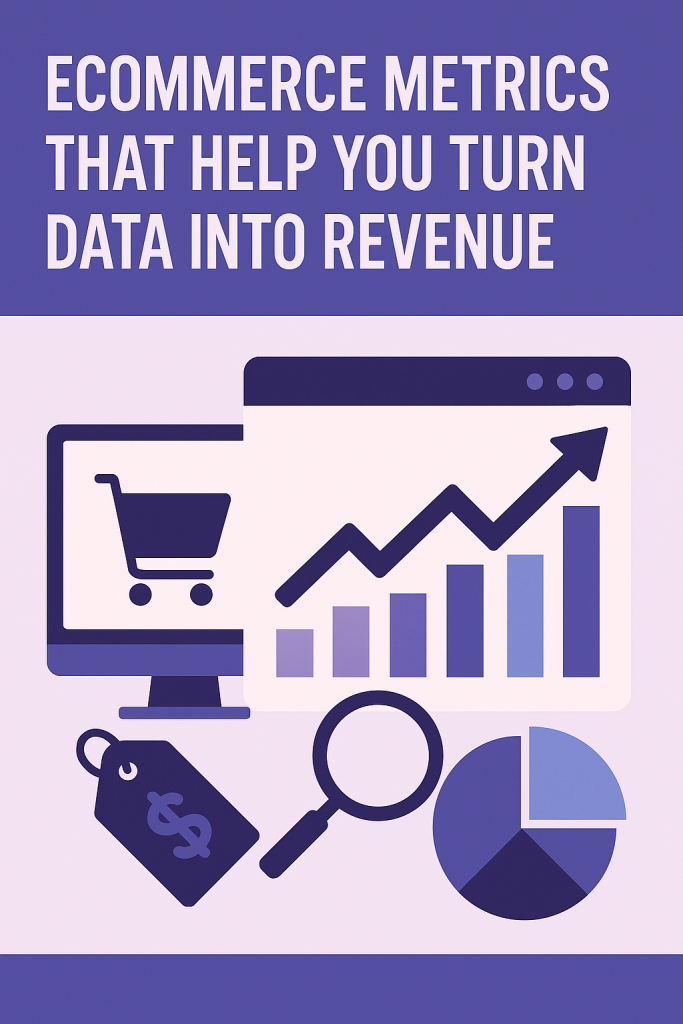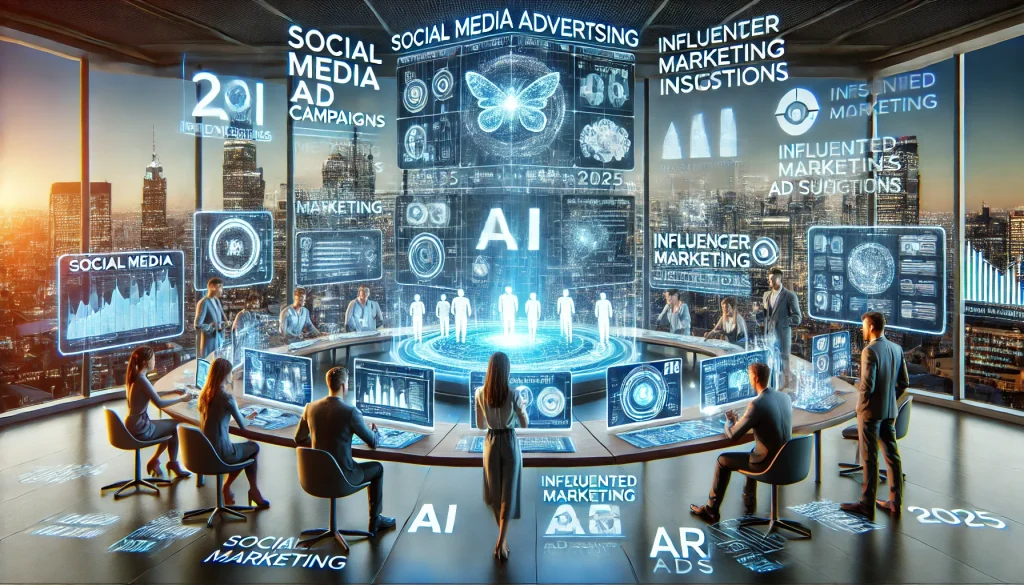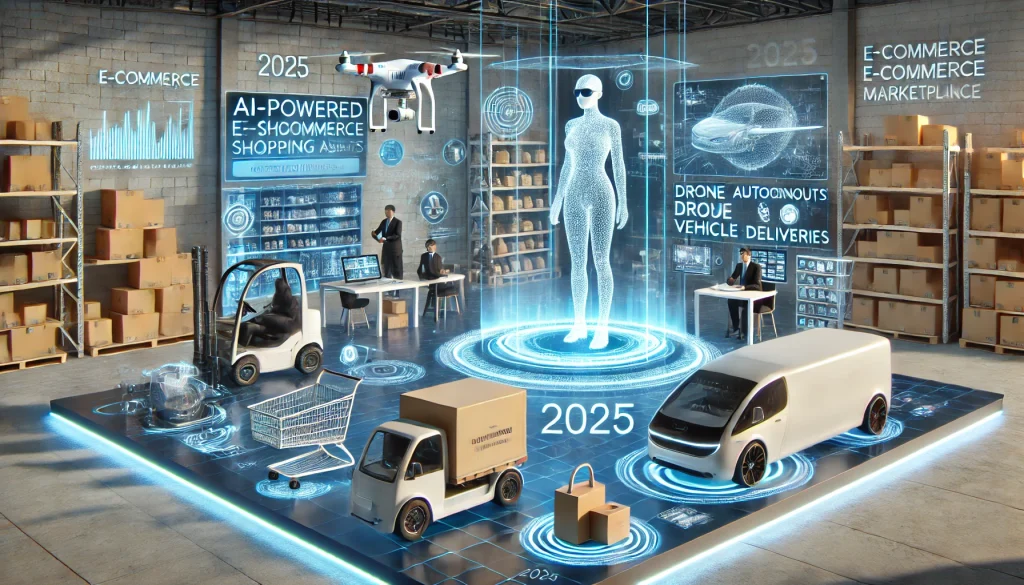Is it Worth It? How to Evaluate the Success of Your Website Redesign

You’ve invested time, energy, and capital into website redesign services, maybe even revamped your brand entirely. But now that your new site is live—what’s next? Was the investment worth it? A website redesign is more than a visual facelift. It’s a strategic move aimed at boosting performance, enhancing user experience, and increasing conversions. However, to ensure you’ve actually moved the needle, you must measure success through clear, actionable KPIs. In this blog, we’ll explore the most effective ways to evaluate your redesign and determine whether it delivered true ROI—or just pretty pixels. 1. Set Clear Goals Before You Launch The first step to evaluating success is knowing what you’re measuring against. Every redesign should be aligned with specific business objectives. Common Goals Include: If your redesign didn’t begin with goal-setting, start now by defining what “success” looks like for your brand. 2. User Experience Metrics: Are Visitors Enjoying the New Design? User Experience (UX) is at the forefront of every effective redesign. Good design guides users toward actions—great design makes those actions frictionless. Key UX KPIs: If these metrics improved, then your custom web development and UX decisions are paying off. 3. Conversion Rates: Is the New Design Driving Action? The primary goal for most websites is to convert visitors—whether that means purchases, sign-ups, downloads, or form submissions. Comparing pre- and post-redesign conversion rates is critical. Metrics to Watch: Tip: Use A/B testing tools like Google Optimize to experiment with CTA placements, layouts, and messaging post-redesign. 4. SEO Performance: Did Your Rankings Survive the Makeover? A poorly executed redesign can sabotage search engine visibility. A well-executed one will maintain or even enhance it. SEO Metrics to Evaluate: Working with a developer skilled in responsive website design ensures mobile-first optimization, which is now critical for Google rankings. 5. Mobile Responsiveness: Is It Truly Mobile-First? With more than half of global traffic coming from mobile, your redesign must excel on smartphones and tablets. Test With: If mobile bounce rates have dropped and engagement has increased, your responsive website design is doing its job. 6. Website Speed: Faster = Better Speed kills—especially slow websites. Site performance plays a major role in both UX and SEO. Use Tools Like: Improve By: If your bounce rate is dropping and conversion rate is rising, performance upgrades from your website redesign services are likely a key factor. 7. Heatmaps and Session Recordings: Watch Real Users in Action Numbers are valuable, but behavioral tools offer goldmines of insight. Tools to Use: Watch how users navigate, where they get stuck, and where they click. These qualitative insights validate your redesign decisions—or highlight where tweaks are needed. 8. Accessibility Improvements: Inclusive Design = Better Results Designing for accessibility not only expands your audience—it often leads to better UX for everyone. Evaluate: Accessibility improvements can indirectly impact bounce rate, engagement, and conversion rates—especially on forms and navigation menus. 9. Technical Health: Is Your Backend Built to Last? A polished front end needs a robust back end. Quality custom web development ensures fast load times, fewer errors, and a smoother user journey. Key Checks: If your site is throwing fewer errors and your time-to-first-byte (TTFB) is faster, the backend overhaul was a win. 10. ROI: The Ultimate Success Indicator All your metrics feed into one final judgment: return on investment. Did the money you spent on redesign actually increase revenue or leads? Formula:ROI = (Net Profit from Redesign – Cost of Redesign) / Cost of Redesign x 100 Track long-term benefits like: A high ROI means your website redesign services investment was absolutely worth it. 11. Stakeholder and Customer Feedback: Gut-Checks Matter Too Don’t ignore qualitative feedback. What do customers, clients, and internal teams say about the new design? Collect Feedback From: Sometimes the clearest signals of success come from the people actually using your site. Measure What Matters, Then Iterate The only way to know if your redesign was “worth it” is by measuring real results. Evaluate success based on a mix of hard data and human feedback. Look beyond the aesthetics and dive deep into UX, SEO, performance, and ROI. At SpeedDot360, our website redesign services, responsive website design, and custom web development ensure your digital investment pays dividends. We don’t just design websites—we build platforms that drive growth.
Ecommerce Metrics That Help You Turn Data Into Revenue

In the competitive world of ecommerce, simply launching a store with a sleek online store design isn’t enough. To drive scalable growth, you need to measure what matters. That’s where ecommerce metrics come in. They are not just numbers—they are critical insights that, when used right, can lead to smarter decisions and more revenue. Think of your data as a GPS for your ecommerce business. Without tracking the right metrics, even the best custom ecommerce solutions won’t reach their full potential. Let’s dive into the most important ecommerce metrics that bridge the gap between raw analytics and real profit. 1. Conversion Rate (CR): The Core of Ecommerce Growth Conversion rate is the most obvious yet most underutilized ecommerce metric. It tells you how many of your visitors are actually becoming customers. If your beautifully built ecommerce website design isn’t converting, it’s not doing its job. Formula:Conversion Rate = (Number of Sales / Number of Visitors) x 100 Tips to Improve: 2. Customer Acquisition Cost (CAC): Know What You Pay to Get Customers CAC is what it costs to acquire a new customer, including marketing, sales, and advertising expenses. High CAC with low return is a sign of inefficiency. Formula:CAC = Total Marketing Costs / Number of New Customers Acquired Optimization Strategies: 3. Average Order Value (AOV): Increase the Cart, Increase the Revenue AOV reveals the average amount spent each time a customer places an order. It’s easier to increase the size of the cart than to acquire a new customer. Formula:AOV = Total Revenue / Number of Orders Growth Hacks: 4. Customer Lifetime Value (CLV): Think Long-Term, Not Just Per Sale CLV measures the total amount of money a customer is expected to spend with your business over their entire relationship with you. It helps determine how much you should spend on acquisition and retention. Formula:CLV = AOV × Purchase Frequency × Customer Lifespan How to Maximize CLV: 5. Shopping Cart Abandonment Rate: A Hidden Leak in the Funnel Almost 70% of ecommerce shoppers abandon their carts. That’s a lot of lost potential revenue. This metric tells you where people are bailing out and why. Key Fixes: 6. Return on Advertising Spend (ROAS): Are Your Ads Working? ROAS shows how much revenue you generate from every dollar spent on advertising. It’s crucial to understand which campaigns are profitable and which aren’t. Formula:ROAS = Revenue from Ads / Cost of Ads Best Practices: 7. Site Traffic: Don’t Just Count Visits—Segment Them Getting people to your store is step one, but understanding who they are, where they come from, and what they do is next-level insight. Track: Use these insights to optimize both ecommerce SEO services and paid strategies. 8. Bounce Rate & Exit Rate: Understand Why People Leave Bounce rate shows single-page visits, while exit rate reveals where users are leaving your site. High bounce or exit rates from product pages? You’ve got a UX or trust issue. Reduce Bounce Rates: 9. Product Performance Metrics: What’s Hot and What’s Not Understanding which products sell well—and which don’t—is critical for inventory, marketing, and pricing decisions. Metrics to Watch: Apply this data to upsell tactics and feature high-performing products on homepage or ad creatives. 10. Email Marketing KPIs: Your Revenue-Generating Engine Email marketing isn’t dead—it’s thriving when done right. Track metrics like open rates, CTR, and revenue per email to refine campaigns. Metrics to Improve: Personalization is key. Use customer behavior and segment your list accordingly. 11. Customer Retention Rate: Growth Isn’t Just Acquisition Repeat customers are more profitable. Tracking retention gives insight into customer satisfaction and loyalty. Formula:CRR = ((E-N)/S) x 100Where:E = Customers at endN = New customersS = Customers at start Boost Retention: 12. Net Promoter Score (NPS): Would They Recommend You? This particular survey asks customers how likely they are to recommend your store. It’s a strong indicator of customer experience and brand loyalty. How to Use NPS: 13. Site Speed & Mobile Responsiveness: Underrated but Crucial A slow site means lost sales. Google also factors in site speed for rankings, impacting your ecommerce SEO services. Tools: Compress images, use caching, and choose fast hosting for best results. 14. Checkout Funnel Metrics: Find and Fix Drop-Offs Use Google Analytics or heatmaps to see where users drop off in your checkout process. Streamlining these steps increases your overall conversion rate. Focus Areas: 15. On-Site Search Metrics: Uncover What Shoppers Really Want Track what users are searching for and whether they find it. This helps in optimizing custom ecommerce solutions like product categorization and inventory. Track: Use this data to create new collections, improve navigation, or launch new products. Conclusion Data without action is just noise. By monitoring the right ecommerce metrics, you can steer your store toward higher conversions, lower acquisition costs, and more loyal customers. Whether you’re refining your ecommerce website design, investing in smarter ecommerce SEO services, or developing custom ecommerce solutions, metrics are the fuel for revenue growth.
Revolutionizing Social Media Advertising Trends of 2025

Social media advertising is evolving faster than ever, with platforms introducing innovative features, AI-driven insights, and advanced targeting capabilities. As businesses strive to stay ahead, mastering the latest social media strategy development trends will be crucial for success in 2025. In this blog, we’ll explore the biggest social media advertising trends shaping 2025 and how businesses can optimize their digital marketing strategies. AI and Automation: The Future of Social Media Advertising AI is transforming paid social media advertising, enabling businesses to optimize targeting, content creation, and audience engagement. Rather than relying on traditional methods, AI-driven automation now personalizes ad experiences, predicts user behavior, and streamlines the ad placement process. Artificial Intelligence (AI) is revolutionizing paid social media advertising by enhancing targeting accuracy, optimizing ad delivery, and personalizing user experiences. Key AI-driven trends include: Automated Ad Creation: AI-generated ad copies and visuals tailored to audience preferences. Predictive Analytics: AI forecasts user behavior, improving ad targeting and conversions. Chatbot Integration: AI-powered chatbots facilitate instant interactions and customer engagement. Brands that integrate AI into their advertising strategies will have a competitive edge by improving efficiency and audience engagement. Video Content Continues to Dominate Short-form videos, interactive live streams, and immersive content remain at the front of social media strategy development. Platforms like Instagram Reels, TikTok, and YouTube Shorts provide businesses with an engaging way to showcase products, tell brand stories, and foster audience interaction. With platforms like TikTok, Instagram Reels, and YouTube Shorts leading the way, short-form videos continue to dominate social media management strategies. In 2025, businesses should focus on: Engaging, high-quality content that captures attention within the first few seconds. Shoppable videos that permit users to purchase directly from the platform. Interactive elements like polls, Q&A, and live shopping events to enhance engagement. Short-form videos provide an authentic way for brands to collaborate with their audience and drive conversions. The Emergence of AR, VR, and the Metaverse With the growing popularity of AR and VR experiences, brands are using these technologies to create interactive advertising campaigns. From virtual try-ons to immersive shopping experiences, AR and VR are redefining consumer engagement on social media platforms. AR and VR are transforming how brands interact with consumers, making advertising more immersive and interactive. Key trends include: AR Filters & Try-On Features: Users can visualize products before purchasing (e.g., virtual makeup try-ons). VR Shopping Experiences: Brands create virtual storefronts for customers to discover products in a digital space. Interactive 3D Ads: Engaging ad formats that enhance user experiences on platforms like Instagram and Snapchat. As AR/VR adoption increases, businesses incorporating these technologies into their advertising strategies will see higher engagement and conversion rates. Hyper-Personalization in Advertising Personalized advertising will reach new heights in 2025, driven by AI and data analytics. Key developments include: Dynamic Content Customization: Ads tailored to individual preferences, behaviors, and demographics. User-Generated Content Integration: Leveraging customer testimonials and influencer content for more authentic promotions. Predictive Retargeting: AI analyzes browsing patterns to serve hyper-relevant ads. Consumers now expect highly personalized experiences, making this trend essential for boosting engagement and ROI. Social Commerce Becomes the New Norm The incorporation of e-commerce into social media platforms is revolutionizing online shopping. Platforms like Instagram, TikTok, and Facebook allow users to browse and purchase products seamlessly, making social media management a key component of sales-driven strategies. Social commerce is redefining online shopping by merging e-commerce with social media platforms. Notable trends include: One-Click Purchases: Seamless checkout experiences within social apps. Livestream Shopping: Real-time product demonstrations with instant purchasing options. AI-Powered Recommendations: Personalized product suggestions in accordance with user interactions. Brands leveraging Instagram marketing services and Facebook Shops will capitalize on social commerce trends in 2025. Increased Focus on Privacy and Ethical Advertising With rising concerns over data privacy, brands must adapt to new regulations and ethical advertising standards. Important developments include: Cookie-Less Targeting: Shifting from third-party cookies to first-party data and contextual targeting. Transparent Advertising Practices: Clearly communicating data usage policies to users. Ethical AI in Advertising: Ensuring AI-generated content is unbiased and respects user privacy. Brands prioritizing privacy-compliant advertising strategies will build trust and maintain customer loyalty. Redefining Influencer Marketing in 2025 Influencer partnerships are evolving beyond traditional collaborations. Brands now prioritize micro-influencers, AI-driven influencer selection, and performance-based contracts to ensure more meaningful engagement and tangible ROI. Influencer marketing continues to grow, but in 2025, authenticity and niche collaborations will take center stage. Key shifts include: Micro and Nano Influencers: Smaller influencers with highly engaged audiences drive more authentic interactions. AI-Powered Influencer Matching: AI tools connect brands with the most suitable influencers. Performance-Based Partnerships: Brands focus on measurable ROI rather than follower count. Businesses that refine their influencer marketing strategies will see higher engagement and conversion rates. Audio Advertising on Social Media With the dynamic surge of podcasts and audio-based platforms, social media audio advertising is gaining traction. Popular trends include: Voice Search Optimization: Ads optimized for voice search queries. Interactive Audio Ads: Engaging audio experiences with call-to-action prompts. Podcast Sponsorships: Brands collaborating with podcasters to reach niche audiences. Incorporating audio ads into social media strategy development ensures a well-rounded marketing approach in 2025. Cross-Platform Integration As users engage with multiple platforms, brands need a cohesive cross-platform advertising strategy. Key considerations include: Consistent Branding Across Channels: Unified messaging across Facebook, Instagram, TikTok, and LinkedIn. Omnichannel Marketing Strategies: Seamless experiences across social media, email, and websites. Automated Content Scheduling: AI-powered scheduling tools for optimized posting times. Cross-platform integration enhances brand visibility and strengthens audience engagement. Diversification of Social Media Ad Platforms While Facebook remains a powerful advertising channel, brands are shifting towards a multi-platform approach, investing in LinkedIn ads for B2B marketing, TikTok for younger audiences, and emerging social networks for niche markets. Facebook remains a leading force in social media advertising, but platforms like TikTok, LinkedIn, and emerging networks are reshaping digital marketing. Future trends include: AI-Powered Facebook Ad Optimization: Automated bidding and audience segmentation. LinkedIn B2B Advertising Growth: Increased investments in professional networking ads. TikTok’s Continued Expansion: Short-form video advertising innovations. Brands that diversify
How E-commerce Is Like In 2025 | Current Trends & Insights

Technology is rapidly evolving, and the way e-commerce businesses operate is changing unprecedentedly. By 2025, companies that leverage the latest digital strategies will have a competitive edge. With advancements in ecommerce website design, automation, AI-driven analytics, and sustainability, online retail is transforming to meet growing consumer expectations. We understand the cruciality of staying ahead in this rapidly changing industry. This guide explores the latest e-commerce trends, platform developments, and insights that will shape online retail in 2025 and beyond. What is the Future of E-commerce in 2025? By 2025, the efficiency and speed of e-commerce operations will heavily depend on supply chain innovations. Integrating AI, automation, and drones into logistics ensures faster deliveries, better inventory management, and sustainable business practices. Key Innovations Driving E-commerce in 2025: AI and Machine Learning: Personalized recommendations, predictive analytics, and chatbot assistance enhance the shopping experience. Sustainable Logistics: Green supply chains, electric delivery vehicles, and eco-friendly packaging reduce the environmental impact. Faster Fulfillment: Drone deliveries and automated warehouses ensure speed and accuracy in order processing. Enhanced Security: Blockchain technology secures online transactions, reducing fraud risks. As technology goes further ahead, businesses must adapt to stay competitive, ensuring seamless shopping experiences through custom eCommerce solutions and streamlined operations. What is the Future Scope of E-commerce? E-commerce is predicted to continue its rapid growth, presenting immense opportunities for businesses that innovate and adapt. Growth Potential: In 2023, e-commerce accounted for over 19% of global retail sales. By 2027, this number is projected to surpass 24% of total global retail sales. E-commerce sales are forecasted to exceed $8 trillion by 2027. Factors Driving E-commerce Growth: Increased Internet Access: More consumers are shopping online due to widespread internet connectivity and smartphone penetration. Advancements in Technology: AI-driven customer experiences, voice commerce, and automation are enhancing online shopping. Global Circumstances: The COVID-19 pandemic accelerated e-commerce adoption, making digital shopping the norm. Seamless Payment Options: With better payment gateway integration, businesses can offer more flexible, secure, and convenient payment solutions. Businesses that leverage these opportunities will thrive in the evolving e-commerce landscape. According to BigCommerce, e-commerce success in 2025 will be shaped by digital transformation, data-driven strategies, and seamless customer experiences, making it essential for businesses to adapt to cutting-edge technologies and consumer expectations. 10 E-commerce Trends for 2025 & Beyond E-commerce is undergoing significant changes, and these seven trends will define its future: 1. AI-Driven Personalization Machine learning and AI will continue to enhance customer experiences by offering tailored product recommendations, dynamic pricing, and chatbot support. 2. Augmented Reality (AR) Shopping Consumers can visualize products in real-world settings before making purchases, reducing return rates and boosting buyer confidence. 3. Voice Commerce Growth Smart assistants like Alexa and Google Assistant will drive more voice-activated purchases, making shopping more accessible and convenient. 4. Livestream Shopping Interactive live-streamed product showcases will dominate social commerce, allowing customers to buy instantly while engaging with hosts in real time. 5. Subscription-Based Models More businesses will offer curated subscription boxes and automated replenishments, creating steady revenue streams and boosting customer loyalty. 6. Cryptocurrency and Blockchain Transactions Secure, decentralized payments will gain popularity, offering fast and fraud-resistant transactions for global e-commerce platforms. 7. Sustainability and Ethical Shopping Consumers are prioritizing brands that use eco-friendly packaging, carbon-neutral shipping, and fair-trade products. 8. Social Commerce Expansion Social media platforms are becoming key sales channels. Businesses are leveraging Instagram, TikTok, and Facebook Shops to drive direct purchases and enhance customer engagement. 9. Hyper-Personalized Marketing Advanced AI tools enable hyper-personalized email marketing, push notifications, and dynamic website content to cater to individual customer preferences in real time. 10. Faster and Smarter Checkout Experiences With payment gateway integration advancements, one-click checkouts, biometric payments, and digital wallets will make online shopping faster, reducing cart abandonment rates. By integrating these trends into their strategies, businesses can stay robust and cater to the evolving demands of digital consumers. Top 3 E-commerce Platforms That Are Booming in 2025 Picking the right e-commerce platform is essential for business success. In 2025, these three platforms are leading the industry: 1. Shopify With its robust Shopify development services, this platform remains a top choice for small to medium-sized businesses, offering ease of use, powerful integrations, and scalable solutions. 2. WooCommerce For businesses that prefer a customizable approach, WooCommerce development provides flexibility, allowing users to build feature-rich online stores on WordPress. 3. Magento Enterprises seeking advanced scalability opt for Magento website development, benefiting from its high-performance architecture and extensive third-party integrations. Each platform offers unique advantages, making it crucial for businesses to select one that aligns with their growth strategy and online store design needs. Why Partnering with Speed Dot 360 Gives You a Competitive Edge At Speed Dot 360, we specialize in helping businesses establish and grow their e-commerce presence with expert ecommerce website design and custom eCommerce solutions. Our proficiency ensures that your online store is optimized for performance, security, and customer engagement. Why Choose Us? Seamless Shopify Development Services: Build a high-converting store with advanced integrations. WooCommerce Development Expertise: Customize your WordPress e-commerce store for maximum flexibility. Magento Website Development Solutions: Create scalable and powerful enterprise-level stores. Efficient Payment Gateway Integration: Provide your customers with smooth, secure, and multiple payment options. Innovative Online Store Design: Craft visually appealing, user-friendly storefronts that boost conversions. Partner with us to future-proof your e-commerce business and stay ahead of industry trends. Conclusion The e-commerce landscape in 2025 is defined by AI-driven personalization, seamless customer experiences, and sustainability-focused innovations. Businesses that embrace these trends, leverage the right platforms, and optimize their online presence will thrive in the competitive digital market. With Speed Dot 360’s expertise in custom eCommerce solutions, payment gateway integration, and ecommerce website design, we help brands scale and succeed in the fast-evolving world of online retail. Get in touch with us today and take your e-commerce business to the next level!




